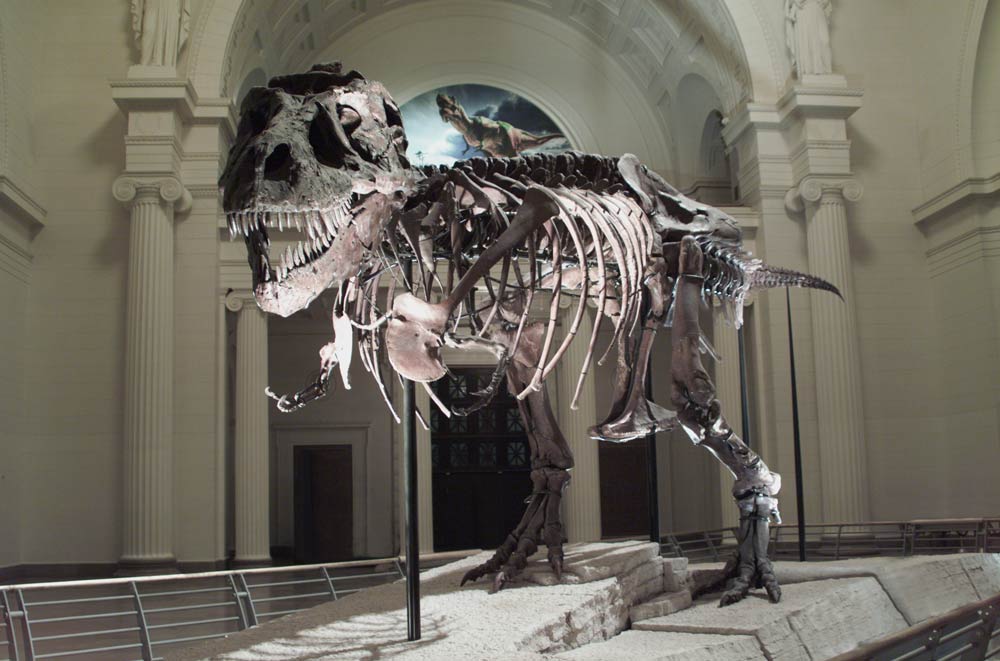Old Thunder Thighs: T. Rex's Weight Topped 9 Tons

The tyrannical lizard T. rex may have been heftier than thought, according to new weight measurements that show at least one individual tipped the scales at more than 9 tons.
The researchers also found that the behemoths packed on the pounds like they were going out of style.
"We estimate they grew as fast as 3,950 pounds (1,790 kilograms) per year during the teenage period of growth, which is more than twice the previous estimate," study researcher John Hutchinson of The Royal Veterinary College, London, said in a statement.
Past attempts to weigh Tyrannosaurus rex were prone to errors as they weren't based on actual skeletons of the deceased dinosaurs, according to the researchers, adding that these errors may explain the newfound heft of T. rex.
"Previous methods for calculating mass relied on scale models, which can magnify even minor errors, or on extrapolations from living animals with very different body plans from dinosaurs," said study researcher Peter Makovicky of the Field Museum of Natural History in Chicago. "We overcame such problems by using the actual skeletons as a starting point for our study."
Scanning skeletons
In the new study, the team scanned five mounted T. rex skeletons to create digital 3-D models; these laser scans are accurate to less than half an inch for skeletons that are up to 40 feet long, the researchers said. [See images of T. rex models]
Get the world’s most fascinating discoveries delivered straight to your inbox.
The scanning wasn't as simple as it sounds. The researchers called in detectives from the Chicago Police Department, who used their forensic scanners to scan the body of what is considered the largest and most complete T. rex, named Sue after its discoverer, paleontologist Sue Hendrickson.
And since Sue's skull was so enormous — measuring about 3.3 feet (1 m) across at the back and 5 feet (1.5 m) long — it wouldn't fit into traditional medical scanners. Solution? The team hauled the noggin to the Ford Motor company, which has a separate facility housing a scanner for engines and the like.
Once the skeletons were scanned, the researchers overlaid a digital skin onto the digitized models in order to get a body volume. The team also modeled separate body parts, such as the head, neck, torso, legs and tail, to make this digital skin-wrapping more accurate.
The mass was then calculated after taking into account empty spaces such as the lungs and mouth cavity.
"For each of five specimens, we generated multiple models differing in degree of fleshiness, at the low end where the muscle adhered pretty tightly to the skeletal outline, and at the other end we'd have a very corpulent or obese dinosaur," Makovicky told LiveScience in a telephone interview.
Results showed T. rex was heavier than previous estimates, which ranged from about 4.5 tons to 6.5 tons, with the Field Museum's Sue skeleton weighing a heaping 9 tons (about 8,164 kilograms). [Gallery: The World's Biggest Beasts]
"We knew she was big but the 30 percent increase in her weight was unexpected," Makovicky said.
T. rex grows up
They also used the five specimens to figure out the giant dinosaur's growth rate. The juvenile served as "our lower end of the spectrum, so we could look at how body mass changed over time and how different body parts would've changed from juvenile to adult," Makovicky said.
As far as how massive a baby T. rex might have been, Makovicky said they chose a somewhat arbitrary value of 11 pounds (5 kg). "We know they can't get much bigger than that because you get into a range for a certain-size animal where the volume of the animal [would require that] the eggshell get too thick and they can't get out."
They found most of its growth likely occurred between T. rex's teen years of 10 to 12 and 17 to 18, when T. rex reaches maturity. Though packing on thousands of pounds each year, particularly in this teenage period, sounds like a lot, the new growth rate is more similar to growth-rate calculations for other dinosaurs, the researchers said.
"Our new growth-rate value actually erases a deficit between the previous growth-rate estimate and what is expected for a dinosaur of this size," Makovicky said.
But the quick track to thunder thighs came at the cost of speed and agility, the team found. Turns out, as the animal grew it also became slower, likely because its torso got longer and heavier while its limbs grew relatively shorter and lighter. The result shifted its center of gravity forward.
"That shift changes a lot of the inertial properties, by shifting the mass forward you're shifting the pivot point away from the hips, which is the natural pivot, so that requires bigger muscles," Makovicky told LiveScience. "T. rex has pretty large, in fact, enormous leg muscles, probably the largest leg muscles of any creature that ever lived, but a lot of that leg muscle had to stabilize the animal and didn't translate into speed."
As such, even with such thunder thighs, these dinosaurs must have slowed down as they grew, with a juvenile being relatively faster and more agile than an adult.
Their findings are detailed online this week in the open-access journal PLoS ONE.
Follow LiveScience for the latest in science news and discoveries on Twitter @livescience and on Facebook.
Jeanna Bryner is managing editor of Scientific American. Previously she was editor in chief of Live Science and, prior to that, an editor at Scholastic's Science World magazine. Bryner has an English degree from Salisbury University, a master's degree in biogeochemistry and environmental sciences from the University of Maryland and a graduate science journalism degree from New York University. She has worked as a biologist in Florida, where she monitored wetlands and did field surveys for endangered species, including the gorgeous Florida Scrub Jay. She also received an ocean sciences journalism fellowship from the Woods Hole Oceanographic Institution. She is a firm believer that science is for everyone and that just about everything can be viewed through the lens of science.
